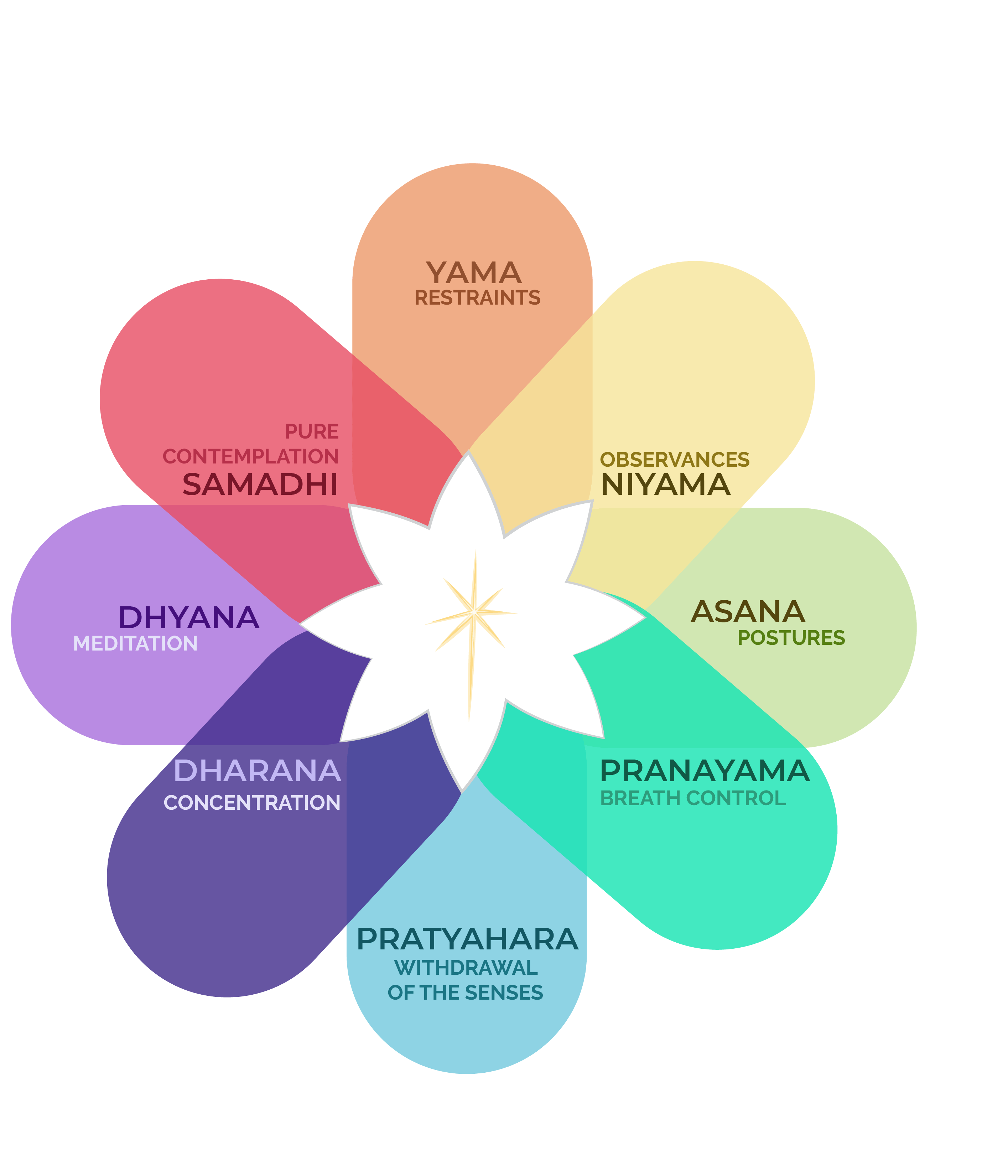
In the west we often equate Brahmacharya with celibacy. But the practice of Brahmacharya offers so much more than a lesson in how humans react without sexual intercourse. Unbroken Brahmacharya in any form, provides insight to how the mind works and helps us understand our behaviors more.
It’s a way human beings can obtain more consciousness and self awareness. In this post, we’ll cover all things Brahmacharya — what it is, it’s history, intricacies, and benefits and how you can practice it.
What Is Brahmacharya? The Fourth Yama in Yoga
As part of the first limb on the yogic path, the yamas are an exploration of your relationship to others.
Like on any spiritual path to consciousness, as we deepen our relationship to others, we deepen our relationship to ourselves. In Sanskrit, Brahma means creator, and Charya means behaviour.
Brahmacharya, in its literal translation, means the path to Brahman, or path to god. However, many translate it as the right use of energy.
Interpretations of Brahmacharya and How it’s Applied
Some interpretations of Brahmacharya include:
- Union
- Continence
- Self control
- Restraint
- Abstinence
- Sexual repression
- Moderation
When we hear this word, Brahmacharya — abstaining — we often think of abstaining in the sexual sense. And it refers to that, sure. But that doesn’t mean we have to take it to the extreme — no sex, no reproduction, no more humans (uh oh!).
Exercising Brahmacharya in a sexual sense can simply mean not misusing sex. It can be abstaining from sex if we recognize that we are engaging in it as a form of addiction, or as a means of trying to fulfill self-worth, seeking attention, or trying to feel whole.
However, this does not only have to relate to sexual desire. You can abstain from keeping sweets in your apartment. If you’re the type of person who eats the whole pint of ice cream in one sitting (no judgment!), then maybe abstaining from having it in the house is your type of challenge. Instead, consider allowing yourself a treat when you’re out with friends and exercise moderation.
Brahmachraya can refer to removal of any addictive or unhealthy behaviour – misuse of sex, excessive shopping, gambling, poor eating, poor personal health habits, or any destructive behaviours. That being said, you don’t have to think of Brahmacharya as deprivation or lack. You can also see Brahmacharya as a beautiful, humble way of removing or limiting something to make room for all of the other Yamas.
When we abstain from or use moderation with unhealthy thoughts and actions (Brahmacharya), we provide care (Ahimsa) to self and others, we allow for the space to look at the truth (Satya), we don’t rob ourselves of potential loving relationships that unhealthy behavior can get in the way of (Asteya). We stop clinging to things we think will make us happy (Aparigraha).
Who Invented Brahmacharya? A Brief History.
As a Yama, Brahmacharya comes from the The Yoga Sutras of Patanjali. We believe Patanjali compiled the Sutras sometime between 500 BC and 400 AD, but that’s a big span of time! So understandably, the details are a little fuzzy.
Sutra, meaning thread in Sanskrit, connects yogic principle to life experience. Joan Shivarpita Harrigan, a psychologist and the director of Patanjali Kundalini Yoga Care said, “Patanjali has offered us guidelines that will allow us to have enhanced emotional and mental well-being and a more fulfilling and meaningful life.”

Those guidelines include the 8 limb path, starting with the Yamas, or moral principles. Brahmacharya, being the fourth principle, allows our decisions to be more aligned and conscious.
Some people debate whether the Yoga Sutras were written by one man, or if the book was a culmination of a group of people — his students. Some theories even suggest the name might refer to that group of people instead of one individual being.
Is Celibacy Necessary for Brahmacharya?
In short, it depends who you ask — it can be a controversial question! Many argue that moderation is the sustainable path in Brahmacharya. Others believe that sexual abstinence is necessary to truly embody this virtue.
Those practicing celibacy feel that an all or nothing approach is the only path. After all, monks who sit in meditation to seek control over their vital energy by avoiding sense pleasures.
Each person embarking on this path will have a different experience. Exercising Brahmacharya in a sexual sense can simply mean not misusing sex. It can mean abstaining from sex if we recognize that we are engaging in it as a form of addiction, or as a means of trying to fulfill self-worth and seeking attention. It can also mean full-on celibacy if that’s where you feel your path leads.
In the modern world, those embarking on this path are less likely to explore a life of total abstinence and more likely to take on periods of celibacy to gain power over the senses. No matter what path of Brahmaacharya you choose, the intention behind the path remains the same— right use of energy.
What Are the Benefits of Brahmacharya?
Brahamcharya is an important step for deeply exploring the mind-body connection and spiritual process. By limiting the automatic response to giving in to your desires, people become curious with the nature of that desire, and subsequently improve mindfulness.
Some examples of benefits to practicing Brahmacharya include:
- Access to Life Force: in yoga classes, when a yoga teacher cues breath retention we exercise the lungs, allowing more expansive access to prana, or life force.
- Vital Energy: by conserving sexual energy, we create space to utilize that energy in other ways, creatively, spiritually, and in being more authentic with ourselves and the world.
- Mindful Responses: when we remove the habit of being on autopilot with sex and indulgences, we cultivate more mindful responses. If a lustful thought comes up, instead of indulging without thinking, we can pause, get curious with what’s really the motivating factor under that lustful thought, and choose to not succumb to it.
How to Cultivate a Brahmacharya Practice Today (in Modern Times)
Practicing Brahmacharya has a lot to do with raja yoga, but that practice looks very different today than it did in the time of The Yoga Sutras. In our modern world, renunciation is not always easy or possible. It’s important to know that if you want to commit to the fourth yama, there are many paths you can take while still calling it yoga.

Mastery of Energies
The constant business and activity in the modern world wastes a lot of energy. Similarly, when we constantly pine for something or someone, we expend precious energy on that longing, often without a desired outcome.
Even if we get the outcome we think we want, we often start reaching for the next desire, which also uses energy. If we remove attachment to the outcome or the experience, we save ourselves energy and can bring forth peace. This gives us power in conserving energy to be part of the road to brahman. Being able to act with moderation removes the longing, or energy being spent for the longing.
Just how eliminating sweets for a period of time, reduces the energy we spend on the craving. Often, the point is not to alter the outcome but to alter the energy spent on trying to get the outcome. This conserves energy for Brahmacharya.
Celibacy
Celibacy, or spotless chastity, is a tangible way of practicing Brahmacharya. by removing all acts related to sensuality, such as:
- Retaining semen
- Eliminating the use of sense objects
- Avoiding partnered sex
- Avoiding self pleasure
By taking this vow and devoting yourself to a practice of elimination, you are implementing tactical ways to bring Brahmacharya into your life. By removing the power that the mind places on physical senses and all sexual thoughts and acts, celibacy becomes the conduit of Brahmacharya.
Tips to Help You Practice Brahmacharya
Deciding to embark on a life that includes Brahmacharya may seem like a big undertaking. But it doesn’t have to be!
There are ways to turn an all-or-nothing approach into an achievable balance. Simply honoring your word for small steps provides the incentive to continue growing Brahmacharya in your life. To help you get started, these are some areas you may consider.
Practice in Your Yoga Sequence
You can practice Brahamacharya on the mat by listening to your body’s unique needs and practicing healthy control within your practice. This can protect your body from injury and help you get the most out of your yoga practice.
We also gain a valuable lesson in keeping the ego in check, learning that it’s okay if we aren’t doing what the person next to us can do, or where our minds are telling us we “should” be in our practice.
Practice Moderation
Remember a time when you decided you were going to start “eating clean?” Maybe you swore Thanksgiving would not set you askew, and you did very well, until the morning you told yourself one cheat day wouldn’t do any harm.

But Satya tells you it might send you down a slippery, sugary slope. If you can truly have a cheat day and quickly get back to clean eating, that’s moderation at its best. Similarly, if you can use sex as a form of exploring the connection between you and your partner through a sexual act, or connect to your own sexuality through sensual pleasures, without it becoming addictive, it can be a wonderful way of moderately using your sexual energy.
Practice Self Restraint
There is a misconception that self restraint equates to lack or deprivation. However, willingly turning to this practice can actually bring forth a sense of freedom.
When you choose to restrain from a certain activity, or train of thought — in a yoga class, in a relationship, or the way you show up in the world — you’re proving you have freedom from that choice and avoiding any guilt or negative consequences. By creating freedom, you create more energy to show up for the people in your life in more authentic ways. It can create a sense of peace, happiness, the ability to enjoy simple pleasures in life, and even a sense of enlightenment.
Be Intentional With Your Energy
We’ve all heard the phrase, ‘You can’t pour from an empty cup,’ right?
Being intentional with your energy benefits your mind, body and spirit. That can include sexual energy, emotional energy in relationships, or physical energy with how you spend your time.
Meditation, being impeccable with your words, choosing to conserve your time, and learning to say no when it serves you, are all ways to help you decide when to conserve or expend your energy. It all comes back to the right use of energy.
Next Steps
- If you’re interested in practical kriya yoga as a way to improve your daily life and relationships, check out my Yoga for Self Mastery course.
- Order my Yoga Life book for a practical guide to creating balance in your life through yoga.
- Check out my YouTube channel and find some yoga classes that you can try out for yourself!
Experience 3 Training Videos from Inside My 200-Hour Online YTT

YOU MIGHT ALSO LIKE
- What is Kriya Yoga? The Philosophy and Practice
- Uddiyana Bandha: Tapping Into Your Deep Core
- 4 Reasons Hasta Bandha Is Essential To Your Yoga Practice
- Vitarka Mudra: What It Is and How Do You Use It?
- Shakti Mudra: What It Is and How Do You Do It?
- Garuda Mudra: What It Is and How Do You Use It?
- Kali Mudra: What It Is and How Do You Do It?
- Shunya Mudra: What It Is and How Do You Do It?
- Varuna Mudra: What It Is and How Do You Use It?
- Vayu Mudra: What It Is and How Do You Use It?
- Samana Vayu: The Energy of Balance & How to Access It
- Apana Vayu: The Energy of Release & Surrender
- Udana Vayu: The Ascending Wind
- Prana Vayu: The Breath of Vitality
- Vyana Vayu: The Energetic Secret to Flow
Learn how to do 11 of the most popular yoga poses correctly. Free video + PDF download.










